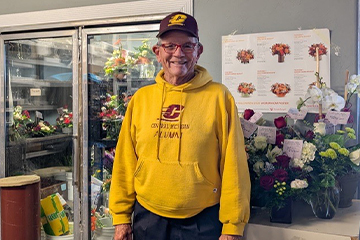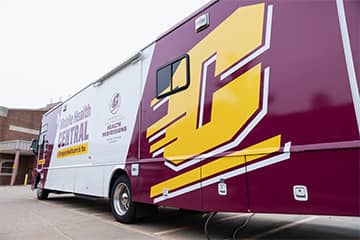50 years leading the field
CMU’s athletic training program celebrates a half-century of excellence
In 1973, Ken Kopke introduced athletic training as a minor course of study at CMU. As the field evolved from a trade into a profession, Central’s program advanced as well, growing into an academic major with accreditation from the National Athletic Trainers’ Association in the 1980s.
Now, 50 years later, the curriculum has expanded again to offer a master’s degree. It’s one of the top programs in the nation with a stellar reputation. At its core, it remains dedicated to the original mission: helping athletes of all ages and sports get and stay healthy.
Warming up to the idea
“Back then, people would major in history or math and then athletic training would be a minor — and sometimes a second minor — for them,” Ron Sendre said.
About 90% of those minoring in athletic training were pursuing teaching credentials and had jobs offered to them before they graduated, he said.
Sendre would know. He co-founded the program with the late Kopke.
But it wasn’t as simple as two faculty members dreaming up a new program and then enrolling students.
Sendre earned bachelor’s and master’s degrees in health education with a focus on athletic training at Ball State University in Indiana. By 1968, he was an associate professor and athletic trainer there. He created an athletic training minor at the school in 1972 and quickly saw the need for expanded education for the field.
In the spring of 1976 at a conference at Penn State University, Sendre presented his idea for an athletic training major. Kopke, who was the head athletic trainer at CMU, was in the audience.
“Ken came up to me after my presentation and said, ‘I want to have breakfast with you tomorrow morning,’ ” Sendre said. “We met the next morning and Ken said, ‘We want you to come to CMU and set up the first major curriculum in the United States.’ ”
By that summer, Sendre and his family were headed for Mount Pleasant.
Kopke is credited with developing CMU’s minor in athletic training. He was Central’s head athletic trainer from 1969 to 1985 and he taught sports medicine at CMU for 16 years. His passion and ideas aligned with Sendre’s.
“We had exceptional support from Bill Theunissen, the dean of the School of Health, Physical Education and Recreation,” Sendre said. “I presented the coursework to the department, and there were no objections.”
The university senate approved the major in 1979. From there, it just blossomed.
“We had students coming from Japan, from across the country because the word spread. Little old CMU had just outdone the University of Michigan, the University of Indiana, Boston College, all these other institutions that wanted to do this first.”
He laughed. “And I loved that.”
Sendre and Kopke stayed at CMU until 1985 when they left to launch Athletic Training Services, a venture funded by a state of Michigan grant to put athletic trainers to work in industry settings.
Working with clients in the automotive sector, they demonstrated how offering athletic trainers and a training room in their facilities would improve the well-being and fitness of workers while saving the companies money.
It was a successful expansion of the field, but Sendre missed working with students, so he returned to campus and stayed until he retired in 2001.
“I’m so proud of the graduates and the contributions they’ve made to this profession and to the athletes they take care of,” Sendre said.
Homegrown leader
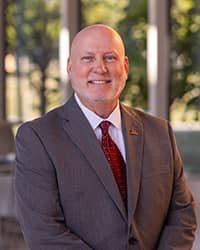
Greg Zimmerman, one of the program’s early graduates, became the associate dean of The Herbert H. and Grace A. Dow College of Health Professions in 2019.
As a CMU student 40 years earlier, Zimmerman, ’84, ’91 M.S.A., wasn’t clear about his career path, but an article in CM Life about a new major in sports medicine caught his attention.
“I thought, ‘I love sports, I’m fascinated by the human body and medicine. Sounds like a perfect match!’ ”
Zimmerman locked in his new major.
“It’s one of those decisions you may make without a lot of information. You say, ‘Hey, this interests me,’ and you reset your goals. It turned out to be wonderful for my career and my life,” he said.
Zimmerman’s internship preceding graduation was working in The Center for Athletic Medicine at Henry Ford Hospital in Detroit, occasionally treating players with the Red Wings, Tigers and Lions. That led to an offer from the MLB’s Atlanta Braves organization to work with their Single-A team, the Sumter Braves in South Carolina.
“Hall of Famer Hank Aaron was my boss,” Zimmerman said. “My father couldn’t believe it.”
That job wasn’t exclusively dedicated to athletic training, though.
“You really do pay your dues in the minor leagues of baseball. I was the bus driver, the clubhouse manager, I did the laundry, I was the traveling secretary handing out meal money. It was quite an eye opener.”
While Zimmerman said he enjoyed every minute of the job, it was also exhausting, and the pay reflected a similar standard as the players at this level. He returned to Michigan to work at General Motors performing physical rehabilitation of injured employees for the next decade. He earned his master’s in health administration and doctorate in education, and he took a career detour into education working at GM University, an internal advanced technical degree program.
His path eventually led him back to Mount Pleasant when he was hired as the associate dean of the College of Health Professions. He credits Sendre and Kopke for lighting the way for his career start.
“They were instrumental in growing the athletic training profession into the industrial/corporate setting,” Zimmerman said. “Those workers suffer the same injuries athletes experience — overuse injuries, strains and sprains. Our skills apply very well in that environment. Going through a hospital-based rehabilitation or community clinic is fine, but having trained people onsite with expertise to treat the injuries is return-to-work efficient and cost effective.”
Zimmerman said he’s proud of the program’s structure that enables students to gain experience in the field from the beginning of their studies.
“Our motto at CMU is WE DO, and the athletic training program is the epitome of that,” he said. “You get lots of experience in the classroom and labs, working hands-on with high school and college athletes before you even graduate. You’re working side by side with your mentors and teachers who are conducting research to keep on the cutting edge of advancements in the field.”
Students and faculty provide health care services for university recreation activities, CMU’s club and intramural sports, emergency departments, and outpatient therapeutic rehabilitation clinics locally and across the nation. Students and faculty also volunteer at events including the Special Olympics Michigan and in area high schools.
“This program’s reputation speaks for itself.”
Building the program
A good portion of that reputation came via the leadership of Rene Shingles.
Shingles came to athletic training the way many people discover the profession: She sustained an injury in high school as a cheerleader and needed rehabilitation. While her initial career interests tipped toward obstetrics, she became curious about athletic training.
“I was interested in how he was treating my shin splints, so I started asking questions,” Shingles said of her high school athletic trainer. “I said, ‘Can I do this too?’ and he said sure.”
Shingles volunteered as a student athletic trainer in high school, working on the sidelines to take care of players. “It wasn’t anything I knew of as a career.”
As a first-generation college student at the University of North Carolina at Chapel Hill, Shingles forged her path in an evolving field. She found her way to Mount Pleasant when Stan Shingles, who is now her husband and CMU’s assistant vice president of student affairs, suggested she join him at Central on a summer break from her teaching job at Newberry College in South Carolina.
“I had the chance to get to know the faculty in the athletic training program and volunteer for Special Olympics Michigan,” Shingles said. “As soon as an opportunity presented itself, I applied for a job in the program.”
She began by teaching in the department of physical education and sport and then spent 15 years as the director of the athletic training program and seven years as department chair.
“It was so important to me to understand and maintain the legacy of our program, the excellence that’s expected of it,” Shingles said.
She recently retired from her leadership roles and continues to focus on teaching and cultural competency in sports medicine. Through her work, Shingles has helped raise the level of awareness and sensitivity to cultural issues for the people receiving treatment from athletic trainers.

“I was lamenting in class one day about not having resources to teach about diversity and cultural competency related to athletic training, and one of my students, Ashley Reed — who’s now Dr. Ashley Reed — said, ‘You just need to write the book,’ ” Shingles said.
So, she did.
Shingles co-authored “Cultural Competence in Sports Medicine,” the first cultural competence textbook used widely by health care providers. She also was the first African American woman inducted into the National Athletic Trainers’ Association Hall of Fame.
She regularly travels domestically and internationally, providing lectures on cultural competence and is working on two new textbooks, “Patient-Centered Care in Sports Medicine” and a book on diversity, equity and inclusion in health care.
“We have an obligation to train culturally competent health care professionals who treat a broad spectrum of people,” she said.
“Athletic training is a health profession, so it is about helping people. It just happens many of our patients are athletes, but they are also in the military, the performing arts, NASCAR, the rodeo and in industry.”
Growing the profession
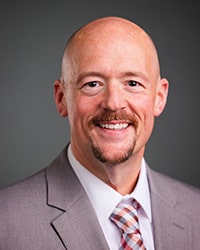
Blaine Long has been teaching athletic training courses at CMU for 10 years. He took over as program director four years ago when Shingles decided to step aside.
Long was drawn to CMU because of the athletic training program’s alignment with the College of Health Professions.
“That strengthens what we can offer future athletic training students and the ways we can help grow the profession,” Long said.
He said the combination of the longevity of CMU’s athletic training program and the smaller size of the university make it a natural draw for prospective students.
“Our class sizes are relatively smaller than other institutions which allows students to have greater interaction with the faculty and their peers,” he said. “In the clinical setting, our students get the chance to do hands-on work with Division I athletes. They can participate in research alongside faculty and develop personal relationships with them that extend beyond their time on campus.”
CMU’s athletic training curriculum goes beyond the traditional classroom setting, offering dual enrollment opportunities for high school students interested in sports medicine.
“It lets students experience a college-level sports medicine class, enabling them to explore their interests at an early stage of their academic career,” Long said.
This early exposure to the field not only helps students make informed career choices but also instills a service-oriented perspective, fostering a desire to help others.
Earning a degree in CMU’s athletic training program can open doors to a variety of career paths, Long said. Graduates have become athletic trainers in high school and college settings as well as outreach sports medicine clinics and physician practices. Others enter medical sales or surgical equipment sales and have even taken their athletic training credits to pursue medical school or other health care fields. Still, most of CMU’s graduates choose to stay within the athletic training profession, providing medical services in high schools, colleges and even professional sports venues.
“We have alumni working at all levels across the profession and beyond,” Long said. And with a program that’s 50 years in the making, that’s thousands of people.
“We’re a pretty tight-knit program with an extensive history,” Long said. “We know where are our alumni are working, we stay connected with them and we help connect new graduates to them. If you graduated from our program, the chances are good you’re still connected to Ron, Rene, me or Emily Webster or Marlene Vandyke who have been instrumental in our program’s growth. We like to do what we can to support everyone.”
This summer, Long received the outstanding athletic trainer educator award from the Great Lakes Athletic Trainers’ Association and the athletic trainer service award from the Michigan Athletic Trainers’ Society (MATS). Shingles, a hall of fame member within the National Athletic Trainers’ Association, was the inaugural recipient of the organization’s DEI award which was named the Rene Revis-Shingles Diversity, Equity and Inclusion Award in her honor. Both Long and Shingles are deeply involved in work being done at the national level, working to help grow the profession and support the next generation of athletic trainers.
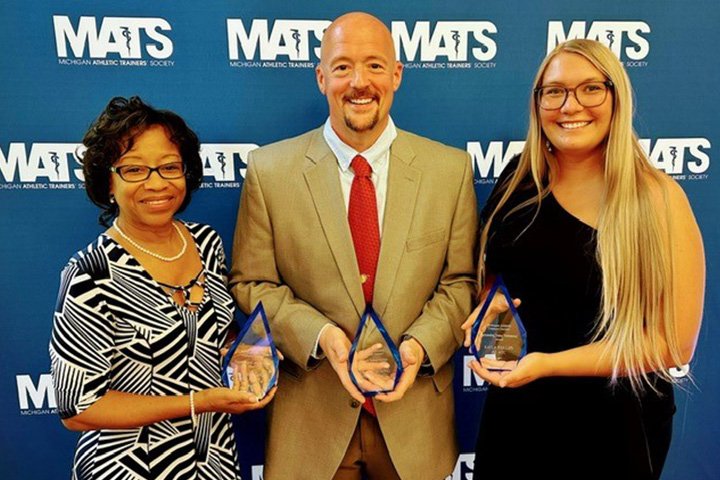
The future of the field
The next chapter of CMU’s athletic training program is already being written.
In 2020, to meet the shifting demands of the athletic training industry and transitioning requirements of the Commission on Accreditation of Athletic Training Education, Central began offering a 3+2 program — three years of undergraduate courses and two years of graduate courses. Students who complete the program earn a Bachelor of Science in Athletic Training (BSAT) and a Master of Science in Athletic Training (MSAT) in five years.
“Like any health or medical discipline, the program has to meet and exceed standards of care and practice,” Zimmerman said. “We have to keep up with advancements in techniques and use of equipment. There is a growing concern among many careers with the advent of artificial intelligence, but the human element will never be removed from athletic training. And at CMU, we’re training that next generation of professionals.”
Long said expanding the curriculum to include both access to coursework at the high school level as well as advanced degrees further enhances CMU’s national and international reputation in the field.
It’s an exciting time to be coming into athletic training, Shingles said. “We are a profession which continues to grow according to the Bureau of Labor and Statistics, and Central offers an unbelievable experience. We have renowned faculty, unbelievable facilities, a simulation center that is top-notch, and dedicated space to study and research sports medicine. There are not many programs across the country who do what we do.”

Both Sendre and Shingles noted that CMU has been supportive of the athletic training program from the very beginning. The program’s profound influence on the profession, along with its unwavering commitment to producing exceptional graduates, continues to make a lasting impact on the field of sports medicine and athletic training.
“I have been here long enough to watch our interns move into leadership positions where they are the directors of sports medicine, they are hiring athletic trainers, and they are calling us to say they have open positions and they are looking for CMU grads,” Shingles said. “To have watched their careers grow to that level is just amazing.”
